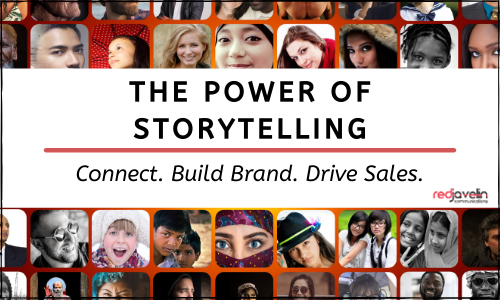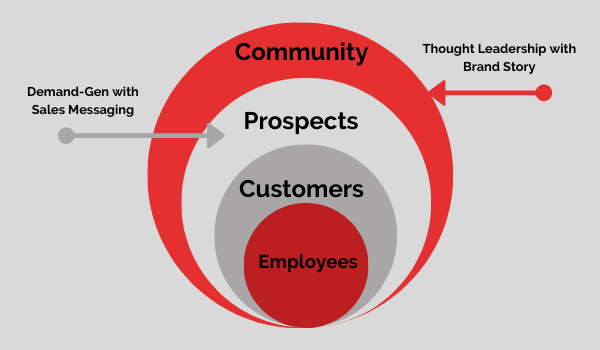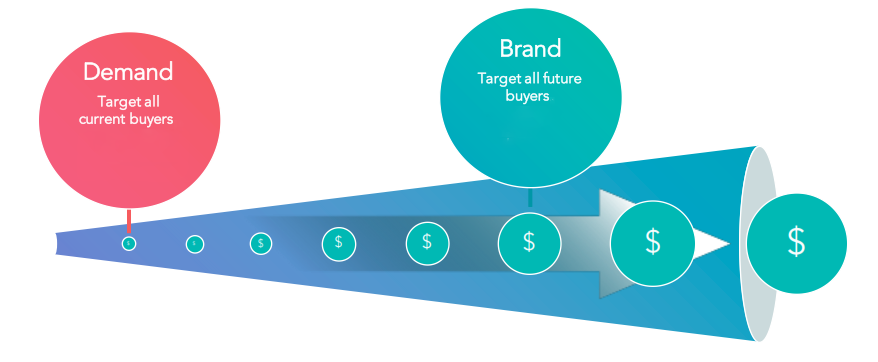 Red Javelin conducts quite a few messaging workshops where we bring together internal stakeholders from executive teams, sales, customer service, development, and marketing to develop brand stories and sales messages. It is common to find that each stakeholder has a different perception and understanding of what “messaging” entails. Many believe that there is a single message to convey. This is definitely not the case. Let's take a closer look.
Red Javelin conducts quite a few messaging workshops where we bring together internal stakeholders from executive teams, sales, customer service, development, and marketing to develop brand stories and sales messages. It is common to find that each stakeholder has a different perception and understanding of what “messaging” entails. Many believe that there is a single message to convey. This is definitely not the case. Let's take a closer look.
The Brand Story
Your brand story is not your mission statement; however, your mission statement is part of your brand story. A mission statement is a formal summary of a company’s line of business; who it sells to, and why it exists or what purpose it serves. A mission statement is the base of all your stories.
A brand story has layers. It is actually a collection of stories, told over time with the goal of building your brand’s reputation and credibility in the market. Each story feeds into an overarching story line and illustrates what type of company you are, your place in the industry, your ability to understand your customers, your vision, what you offer, and what others believe and say about you. You are expanding upon your mission statement with stories about your business, customers, and the problems you solve to make a connection with your audience.
The key word here is illustrates.
It is always better to show rather than tell.
This means that each story requires validating points such as data or customer anecdotes to illustrate a point. It is one thing to say or claim something, but another to show and prove it. For example, if you tell a story that claims that you are the best at what you do, that has little value because it is just a claim made by you.. But if you have a customer tell that same story, even in a quote, then it shows your audience that you are the best.
Brand storytelling is a longer-term game that requires discipline and sustained effort. It is targeted at the broadest possible audience, which includes prospects that don’t know they have a problem, investors, media, influencers, and partners. Brand storytelling helps you connect with people, makes them aware that you exist, and that you are real.

Your Sales Message
Your sales messages are focused and narrower in scope. These messages are for people that understand that they have a problem and are actively looking for a solution.
Your sales messages convince prospects to choose your brand over the competitors and moves them closer to the sale.
Sales messages are crafted around personas – a fictional representation of people that influence a sale – and address the persona’s specific pain points. It could be an ROI calculation for the business stakeholder, technology road map for the CIO, or specific efficiency savings for operations that boosts profitability.
The key here is that the sales message is tailored to a particular audience, with specific pain points, at a particular point in the buyer’s journey with the goal of moving the prospect closer to the sale.

The Importance of Storytelling
Storytelling is a powerful brand-building tool. According to HBR, stories are scientifically proven to get a person’s attention. Stories shape our attitudes, beliefs, and behaviors. In fact, studies have shown that when tension is created in a story, oxytocin is synthesized in the brain, and when the brain synthesizes oxytocin, people are more trustworthy, generous, charitable, and compassionate.
A good story emotionally connects people, an essential element in brand building. Emotionally connected people, sharing the same challenges creates community, another essential element in building momentum for your brand.
And then there is context. A good story takes its audience on journey. It starts with the set-up and begins with framing the context of the story. Context explains the set of circumstances or facts that surround a particular situation and creates the connection, the common ground between the storyteller and the audience. Without context, stories tend to be generalized, vague and not well understood.
In this blog post, we show how Amazon is a master at context. When most companies report success, it is typically done using data and the context they use is a percentage growth over the previous year. For example, Widget Company gre 15% year over year. Amazon used this same formula when they reported that they sold 9X more Echo’s this year than they did last year during the holiday season. But really, what does that actually mean?
9X more than what? Hey, if they sold 1 last season, then they sold 9 more this season. See how vague that is?
Numbers like this have no real context and make no connection with the audience.
In recent years, Amazon has improved its storytelling by providing context for its data to illustrate the scale of the company’s success. For example,
- Customers purchased enough 4K TVs to reach the peak of Mount Everest more than 9 times.
- Customers purchased enough KitchenAid Mixers this holiday to make nearly 7.5 million cookies at once.
- Customers purchased enough copies of the Harry Potter: Complete 8-Film Collection to play consecutively for more than 300 years.
- Customers purchased enough golf balls this holiday that, if lined up, would equal the length of Pebble Beach golf course four times over.
- Customers purchased enough running shoes to run 18,603 times around the globe.
- Customers purchased enough luggage to fill 20 Boeing 747 airplanes.
- Customers purchased enough Char-Broil's The Big Easy Turkey Fryers to cook 225,000 pounds of turkey.
Wow! In my mind, I can visualize TVs stacked as high as a mountain. I can understand the effort it takes to bake 7.5 million cookies and I can imagine golf balls lined up on 17 Mile Drive at Pebble Beach.
The Final Thought
Yes, you need both a strong brand story as well as powerful sales messages. We live in a world filled with sameness and noise. Use great storytelling to help you rise above the competition, build your brand and drive sales.
You may be interested in
What is a Brand Messaging Blueprint and Why Do I Need it?
It's Time to Review Your Company Message and Positioning




